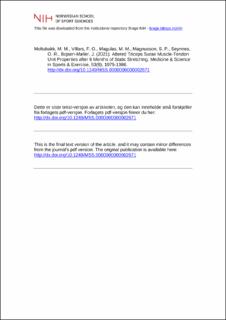| dc.contributor.author | Moltubakk, Marie M. | |
| dc.contributor.author | Villars, Fabienne Olivia | |
| dc.contributor.author | Magulas, Melina Meyer | |
| dc.contributor.author | Magnusson, Stig P. | |
| dc.contributor.author | Seynnes, Olivier R. | |
| dc.contributor.author | Bojsen-Møller, Jens | |
| dc.date.accessioned | 2022-09-15T11:16:00Z | |
| dc.date.available | 2022-09-15T11:16:00Z | |
| dc.date.created | 2021-09-07T18:54:48Z | |
| dc.date.issued | 2021 | |
| dc.identifier.citation | Medicine & Science in Sports & Exercise. 2021, 53(9), 1975-1986. | en_US |
| dc.identifier.issn | 0195-9131 | |
| dc.identifier.uri | https://hdl.handle.net/11250/3018026 | |
| dc.description | I Brage finner du siste tekst-versjon av artikkelen, og den kan inneholde ubetydelige forskjeller fra forlagets pdf-versjon. Forlagets pdf-versjon finner du på journals.lww.com / In Brage you'll find the final text version of the article, and it may contain insignificant differences from the journal's pdf version. The definitive version is available at journals.lww.com. | en_US |
| dc.description.abstract | Introduction: This study examined the effects of 24 wk of daily static stretching of the plantarflexors (unilateral 4 × 60-s stretching, whereas the contralateral leg served as a control; n = 26) on joint range of motion (ROM), muscle–tendon unit morphological and mechanical properties, neural activation, and contractile function. Methods: Torque–angle/velocity was obtained in passive and active conditions using isokinetic dynamometry, whereas muscle–tendon morphology and mechanical properties were examined using ultrasonography. Results: After the intervention, ROM increased (stretching, +11° ± 7°; control, 4° ± 8°), and passive torque (stretching, −10 ± 11 N·m; control, −7 ± 10 N·m) and normalized EMG amplitude (stretching, −3% ± 6%; control, −3% ± 4%) at a standardized dorsiflexion angle decreased. Increases were seen in passive tendon elongation at a standardized force (stretching, +1.3 ± 1.6 mm; control, +1.4 ± 2.1 mm) and in maximal passive muscle and tendon elongation. Angle of peak torque shifted toward dorsiflexion. No changes were seen in tendon stiffness, resting tendon length, or gastrocnemius medialis fascicle length. Conformable changes in ROM, passive dorsiflexion variables, tendon elongation, and angle of peak torque were observed in the nonstretched leg. Conclusions: The present findings indicate that habitual stretching increases ROM and decreases passive torque, altering muscle–tendon behavior with the potential to modify contractile function. | en_US |
| dc.language.iso | eng | en_US |
| dc.subject | flexibility | en_US |
| dc.subject | passive resistance | en_US |
| dc.subject | length tension | en_US |
| dc.subject | ultrasound | en_US |
| dc.subject | stretch tolerance | en_US |
| dc.title | Altered Triceps Surae Muscle-Tendon Unit Properties after 6 Months of Static Stretching | en_US |
| dc.title.alternative | Altered Triceps Surae Muscle-Tendon Unit Properties after 6 Months of Static Stretching | en_US |
| dc.type | Peer reviewed | en_US |
| dc.type | Journal article | en_US |
| dc.description.version | acceptedVersion | en_US |
| dc.source.pagenumber | 1975-1986 | en_US |
| dc.source.volume | 53 | en_US |
| dc.source.journal | Medicine & Science in Sports & Exercise | en_US |
| dc.source.issue | 9 | en_US |
| dc.identifier.doi | 10.1249/MSS.0000000000002671 | |
| dc.identifier.cristin | 1932175 | |
| dc.description.localcode | Institutt for fysisk prestasjonsevne / Department of Physical Performance | en_US |
| cristin.ispublished | true | |
| cristin.fulltext | postprint | |
| cristin.qualitycode | 2 | |
